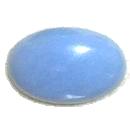|
ClassicGems.net |
|
|
 |
|
Angelite (a variety of Anhydrite) |
|
|
Discovery year unknown; IMA status: Not Valid (tradename for a variety of Anhydrite) |
|||
|
|
|
Chemistry |
|
|
|
|
|
CaSO4 |
|
|
|
Calcium Sulfate |
|
Molecular Weight: |
136.14 gm |
|
Composition: |
Calcium |
29.44 % |
Ca |
41.19 % |
CaO |
|
|
Sulfur |
23.55 % |
S |
58.81 % |
SO3 |
|
|
Oxygen |
47.01 % |
O |
|
|
|
|
|
100.00 % |
|
100.00 % |
= TOTAL OXIDE |
|
|
|
||||
|
Classification |
|
|
|
|
|
Sulfates |
|
|
5/B.04-40 |
|
|
|
7 : SULFATES (selenates, tellurates, chromates, molybdates,
wolframates) |
|
Related to: |
Dehydrated form of Gypsum. Isostructural with Ferruccite. |
|
Members of Group: |
n/a |
|
Varieties: |
Angelite, Bowel Stone, Vulpinite |
|
Synonyms: |
Anhydrous Gypsum, Anhydrous Sulfate of Lime, Cube Spar, Karstenite, Muriacite, Siliceous Anhydrous Gypsum |
|
|
|
|
Crystal Data |
|
|
|
|
|
Crystals tabular on {010}, {100}, or {001} or equant with large pinacoidal faces; elongated along [100] or [001], to 15 cm, with about 40 forms recorded. Typically granular, nodular, parallel or divergent fibrous, massive. Contorted concretionary forms (Bowel Stone). |
|
|
Simple or repeatedly on {011}, common; contact twins rare on {120}. |
|
|
|
|
|
Physical Properties |
|
|
|
|
|
Perfect on {010}, nearly Perfect on {100}, Good to Imperfect on {001}; yielding pseudocubic fragments. |
|
|
Irregular/Uneven, Spintery |
|
|
Brittle |
|
|
3.0 - 3.5 |
|
|
2.96 - 2.98 (g/cm3) |
|
|
Occassionally red under LW UV |
|
|
Not Radioactive |
|
|
|
|
|
Optical Properties |
|
|
|
|
|
Light Blue, light Lylac-Blue, Grayish-Blue |
|
|
Translucent, Opaque |
|
|
Pearly on {010}, Vitreous to Greasy on {001}; Vitreous on {100}. |
|
|
1.567 - 1.618 Biaxial ( + ) |
|
|
0.0420 - 0.0440 |
|
|
Strong; r < v |
|
|
None |
|
|
|
|
|
Occurances |
|
|
|
|
|
Geological Setting: |
A major component in sedimentary evaporite deposits and in the cap rocks above salt domes, commonly formed by dehydration of gypsum; in igneous rocks, fumarolic deposits, and in seafloor hydrothermal chimneys, also an alteration product in hydrothermal mineral deposits. |
|
Common Associations: |
Gypsum, Halite, Sylvite, Polyhalite, Dolomite, Calcite, Magnesite, Celestine, Sulfur |
|
Common Impurities: |
Sr, Ba, H2O |
|
Type Locality: |
Unknown |
|
Year Discovered: |
Unknown |
|
View mineral photos: |
|
|
|
|
|
More Information |
|
|
|
|
|
|
Mindat.org
(Angelite) |
|
|
|
|
Angelite is a trade name for a translucent to opaque, light blue variety of Anhydrite marketed as a gem material. Angelite is named for its "angelic" light blue to lilac-blue color. Anhydrite is named from the Greek word anhydros meaning without water, in allusion to the lack of water in its composition, in contrast to Gypsum, which contains water. Angelite is a trade name for Anhydrite material with an "angelic" light blue or lilac-blue color. Anhydrite is a relatively common sedimentary mineral that is the result of dewatering of the rock forming mineral Gypsum. Good crystal specimens of Anhydrite are extremely rare so faceted gems are also extremely rare. However, fine semi-translucent to opaque specimens of Angelite have been found in Mexico and Peru that have a fine blue color. |
|
|
Angelite gems for sale: We have not photographed our Angelite gems yet. Please check back soon! |